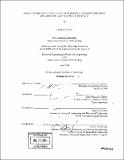| dc.contributor.advisor | Jean-François P. Hamel. | en_US |
| dc.contributor.author | St. Laurent, Daryl, 1979- | en_US |
| dc.contributor.other | Massachusetts Institute of Technology. Biological Engineering Division. | en_US |
| dc.date.accessioned | 2005-09-27T16:49:32Z | |
| dc.date.available | 2005-09-27T16:49:32Z | |
| dc.date.issued | 2004 | en_US |
| dc.identifier.uri | http://hdl.handle.net/1721.1/28528 | |
| dc.description | Thesis (M. Eng.)--Massachusetts Institute of Technology, Biological Engineering Division, 2004. | en_US |
| dc.description | "June 2004." | en_US |
| dc.description | Includes bibliographical references (p. 75-79). | en_US |
| dc.description.abstract | There is reason to believe that embryonic stem cells would grow favorably in a hypoxic environment. These cells come from the pre-implantation embryo, whose native environment is the hypoxic mammalian reproductive tract. Growing stem cells in an environment with higher oxygen levels (i.e. the atmospheric oxygen levels that are normally used to cultivate stem cells) could be bad for the cells, as oxygen is toxic due to its powerful oxidative capacity. In this experiment, J1 murine embryonic stem cells were grown at 0%, 2%, 5%, 10%, and 20% oxygen by volume to assess the effects that lower oxygen levels have on stem cell growth, plating efficiency, and metabolism. Two reaction vessels were built so that the cells could be grown in a controlled environment. Premixed gas cylinders were used to flush the vessels and an optical probe was used to measure the headspace oxygen concentration. Cells were found to grow faster than atmospheric conditions when in a moderately hypoxic environment where the oxygen concentration was between 2% and 10%, and considerably slower than atmospheric conditions as the headspace oxygen concentration approached zero. Maximum cell density decreased, glucose-lactate yield increased, glucose-cell yield decreased, and glutamine-cell yield decreased as headspace oxygen decreased. There were no strong correlations between oxygen concentration and glutamine-ammonia yield or plating efficiency. From the results of this study, it appears that it may be preferable to grow murine embryonic stem cells in a moderately hypoxic environment around 10% oxygen to increase the growth rate while minimizing the maximum cell density and metabolic inefficiency compromises. | en_US |
| dc.description.statementofresponsibility | by Daryl St. Laurent. | en_US |
| dc.format.extent | 79 p. | en_US |
| dc.format.extent | 4284728 bytes | |
| dc.format.extent | 4293062 bytes | |
| dc.format.mimetype | application/pdf | |
| dc.format.mimetype | application/pdf | |
| dc.language.iso | en_US | |
| dc.publisher | Massachusetts Institute of Technology | en_US |
| dc.rights | MIT theses may be protected by copyright. Please reuse MIT thesis content according to the MIT Libraries Permissions Policy, which is available through the URL provided. | en_US |
| dc.rights.uri | http://dspace.mit.edu/handle/1721.1/7582 | |
| dc.subject | Biological Engineering Division. | en_US |
| dc.title | Murine embryonic stem cells and hypoxia : growth kinetics, metabolism, and plating efficiency | en_US |
| dc.type | Thesis | en_US |
| dc.description.degree | M.Eng. | en_US |
| dc.contributor.department | Massachusetts Institute of Technology. Department of Biological Engineering | |
| dc.identifier.oclc | 57363574 | en_US |
